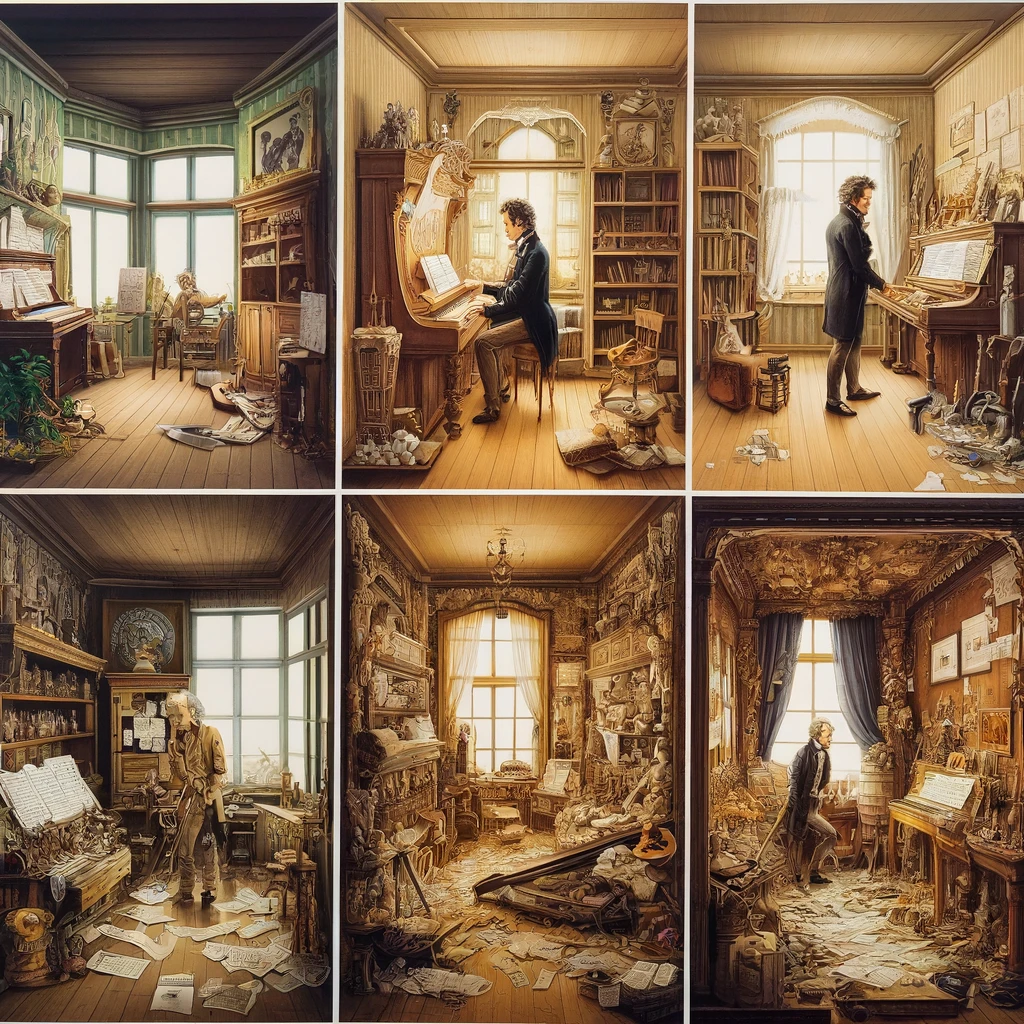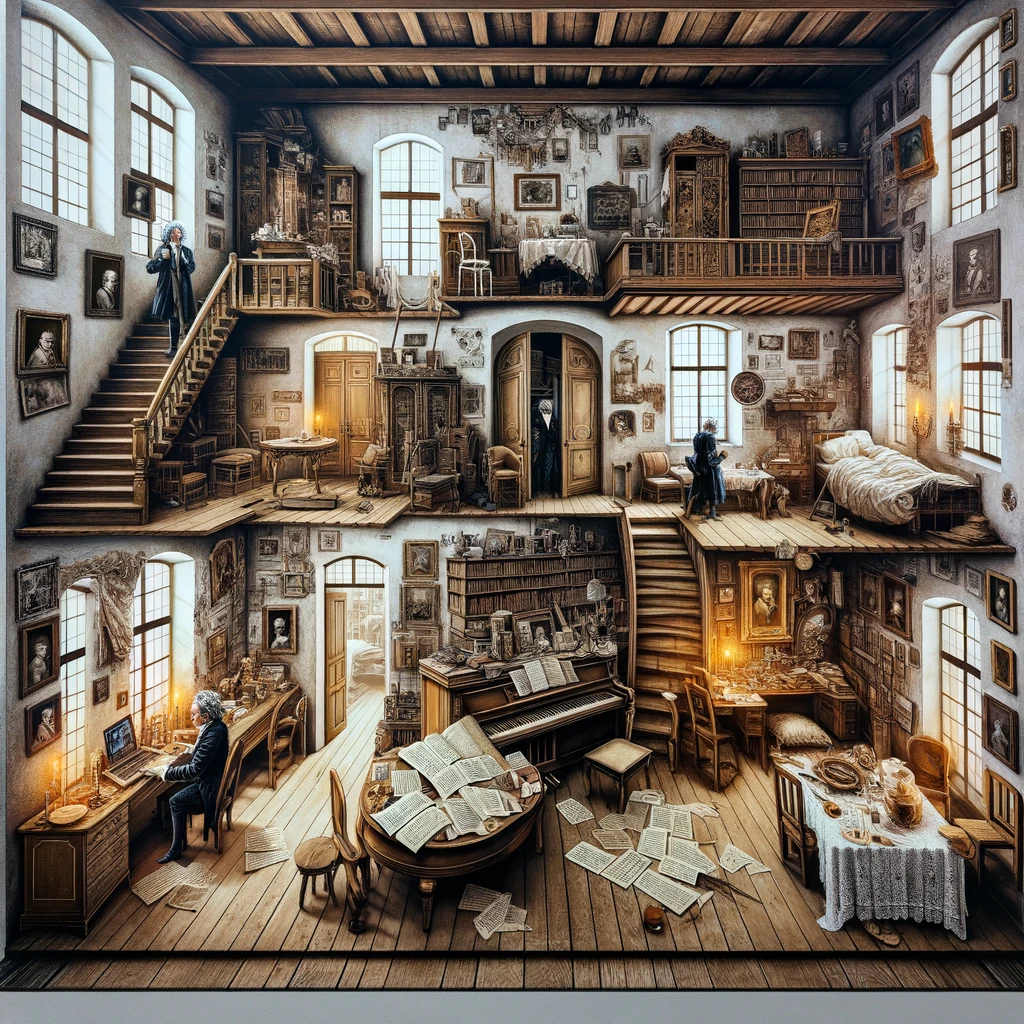
Beethoven’s Homes: Insights on His Creative Spaces
Ludwig van Beethoven, a towering figure in classical music, is known as much for his symphonies and sonatas as he is for his tumultuous life and deafness. However, lesser-known are the stories of the places he called home throughout his life in Vienna, where he composed many of his masterpieces. These residences provide a deeper understanding of his personal challenges and the environmental influences on his work.
Moving to Vienna: The Early Years
Beethoven moved to Vienna in 1792, initially taking lessons from Joseph Haydn. His first known address in the city was at the Pasqualati House, located on the Mölker Bastei, part of the old city fortifications. Owned by his patron Johann Baptist Freiherr von Pasqualati, Beethoven lived in this apartment on and off for almost a decade throughout the early 1800s. It was here that he worked on many significant pieces, including his “Eroica” Symphony and parts of his opera “Fidelio.” The Pasqualati House, with its thick walls and elevated position, offered Beethoven the solitude and silence he increasingly required as his hearing deteriorated.
The Heiligenstadt Testament
In 1802, Beethoven rented a small room in the village of Heiligenstadt, now part of Vienna’s 19th district. This period was a pivotal point in his life, both personally and artistically. Struggling with his worsening deafness, he wrote the famous Heiligenstadt Testament, a letter to his brothers expressing his despair and resolve. Despite his personal crises, this rural retreat inspired a fresh burst of creativity, and the compositions from this period, like the Second Symphony, display an assertive, bold new style.
A Series of Moves: Middle Period
Beethoven’s middle years were marked by a series of moves within Vienna, each residence reflecting changes in his personal circumstances and musical focus. From the Theater an der Wien, where he lived as composer-in-residence and first performed his “Symphony No. 1” and “Symphony No. 2,” to a charming apartment in the Landstraße district, these homes saw the creation of works that pushed musical boundaries. The apartment in Landstraße, in particular, was where he composed the “Pastoral” Symphony, deeply influenced by the natural surroundings that he cherished.
The Schwarzspanierhaus: Final Years
The last years of Beethoven’s life were spent in an apartment in the Schwarzspanierhaus, a building that no longer exists but was located near the site of the University of Vienna. It was a somber period marked by illness and isolation, yet creatively prolific. In this apartment, Beethoven composed the monumental “Ninth Symphony” and the “Miss Solemnis.” These works, characterized by their profound depth and complexity, were written under the most challenging circumstances, showcasing Beethoven’s resilience and genius.
Legacy and Preservation
Today, several of Beethoven’s residences in Vienna are preserved as museums. These sites offer a glimpse into his life and the settings that influenced his compositions. The Pasqualati House, for instance, remains a popular destination for music lovers, housing an exhibit of his life and works, including original scores and personal items.
The homes where Ludwig van Beethoven lived and composed are more than just physical locations. They are testaments to the life of a man who, despite severe personal hardships, produced some of the most enduring music in Western culture. Each apartment tells a story of a different phase in his life, reflecting his evolving musical style and personal struggles. Understanding where Beethoven lived helps us appreciate not just his genius, but also the human spirit’s capacity to overcome adversity and create beauty against the odds.

The Role of Patrons and Visitors
Beethoven’s relationships with his patrons and visitors played a significant role in his life, often dictating his choice of apartments. Patrons like Archduke Rudolph, Prince Lichnowsky, and Baroness Bettina Brentano provided financial support, which allowed Beethoven to rent apartments in more desirable locations. These patrons often visited Beethoven, bringing with them a mix of inspiration and conflict that fueled his creativity. The interactions within these walls sometimes led to the birth of new compositions, as was the case with many dedicated works like the “Archduke Trio.”
The Influence of Vienna’s Cultural Life
Living in Vienna, the heart of Europe’s musical culture during the 18th and 19th centuries, profoundly influenced Beethoven. The city’s vibrant cultural scene provided him with a rich tapestry of experiences and exposures. Apartments close to theaters, opera houses, and other musical venues were particularly significant, as they allowed him to remain connected to the musical community, even as his hearing declined. The cultural stimuli from Vienna’s lively arts scene were critical in the development of his later works, which were revolutionary in their structure and expression.
Architectural and Acoustical Influences
The architecture of Beethoven’s various residences also played a role in his compositions. For instance, the high ceilings and spacious rooms of the Pasqualati House are believed to have influenced the bold, expansive sounds of his middle period symphonies. Conversely, the more confined spaces of his later residences, like the Schwarzspanierhaus, might have contributed to the more intimate, introspective nature of his late quartets. The acoustics of these living spaces provided Beethoven with immediate feedback about his compositions, which was crucial as his hearing faded.
Health and Well-being in His Living Spaces
The state of Beethoven’s health is a significant aspect of his story, especially how it related to the environments he chose. During periods of better health, he preferred living near parks and natural spaces, as seen during his time in Heiligenstadt. Conversely, during his later years, when his health was deteriorating, Beethoven’s choice of residence was more about convenience and necessity rather than preference. The dampness and cold of some apartments worsened his conditions, which is evident from his letters where he frequently complained about these issues affecting his health.
Beethoven’s Creative Process within His Homes
Exploring Beethoven’s apartments also gives us insight into his creative process. Known for his intense work ethic, Beethoven’s composing rooms were often chaotic, filled with manuscripts, pens, and paper strewn about. This organized chaos was part of his creative process, where he could work uninterrupted for hours. Notably, his late apartments had special arrangements to accommodate his piano and his increasing need for quietness due to his deafness.
Impact on Modern Perception
Understanding the spaces in which Beethoven lived and worked also impacts our modern perception of his music. Knowing the specific rooms where pieces like the “Moonlight Sonata” were possibly first played or the “Ninth Symphony” was completed adds a layer of tangible reality to these ethereal works. It allows listeners and scholars alike to connect more deeply with his music, imagining the maestro at work in his various rooms across Vienna.
Conclusion
Beethoven’s residences in Vienna are not merely historical sites but are pivotal in understanding the maestro’s life and work. Each home tells a unique story of a stage in his life—his struggles, triumphs, and the sheer force of his personality. By walking through these homes, whether physically or through narratives, we gain a deeper appreciation of Beethoven as both a composer and a man who navigated immense challenges to leave an indelible mark on music.
References
- Beethoven-Haus Bonn. “Beethoven’s Vienna Apartments.”
- Cooper, Barry. “Beethoven: The Last Decade 1817–1827.”
- Morris, Edmund. “Beethoven: The Universal Composer.”
- Solomon, Maynard. “Beethoven Essays.”
- Swafford, Jan. “Beethoven: Anguish and Triumph – A Biography.”
- Thayer, Alexander Wheelock. “Thayer’s Life of Beethoven.”
- Lockwood, Lewis. “Beethoven: His Music, His Life.”
- Albrecht, Theodore. “Letters to Beethoven and Other Correspondence.”
- Riezler, Walter. “Beethoven.”
- Kinderman, William. “Beethoven.”